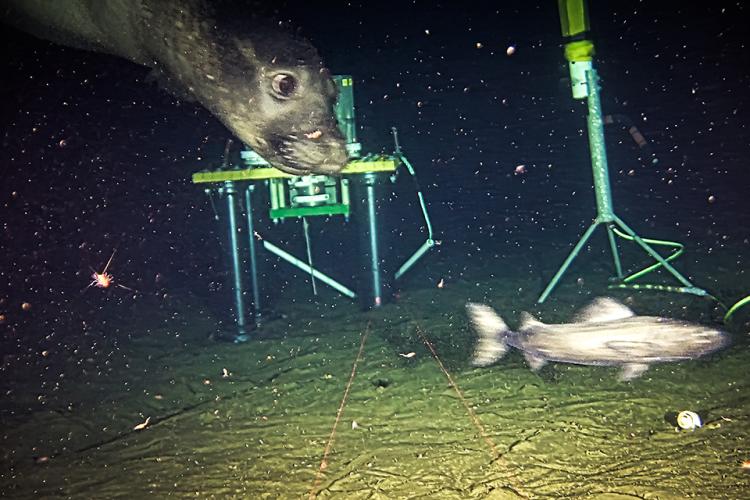
A young, male northern elephant seal (Mirounga angustirostris) chases an offscreen sablefish (Anoplopoma fimbria) at Ocean Networks Canada's NEPTUNE's Barkley Canyon observatory site off the west coast of Vancouver Island, Canada. Credit: Ocean Networks Canada
Northern elephant seals were repeatedly captured on camera in the deep Pacific Ocean using sonar from an Ocean Networks Canada (ONC) observatory as a dinner bell to forage for their next fish feast, according to a new study led by University of Victoria researchers.
The research study published in the peer-reviewed PLOS ONE journal provides a unique, first-ever visual glimpse into the elusive mammal's deep-sea behaviours, with a focus on their sophisticated feeding strategies, prey preferences as well as resting habits.
Altogether, at least eight male elephant seals, ages four to seven, were observed on camera and detected by hydrophones during multiple visits to the 645-metre-deep research site at Barkley Canyon along ONC's subsea cabled observatory NEPTUNE off the British Columbia west coast between 2022 and 2023.
The findings came almost by chance; UVic, Instituto de Ciencias del Mar (ICM-CSIC), a Barcelona-based research institute, and ONC researchers were studying the effects of light and bait on fish and invertebrate behaviour at Barkley Canyon, using a high-definition camera, acoustic imaging sonar, hydrophone, pair of LED lights, and automatic bait release. But a review of the camera, acoustic images and sound data revealed the surprise visitors.
We suspect the seals have learned to associate sonar noise from the research instrument with the presence of food a phenomenon known as the "dinner bell" effect. The seals appeared to use this sound to locate an area with prey and may take advantage of fish disturbed by the camera lights, particularly targeting sablefish, their preferred meal as seen in the video footage,"
Héloïse Frouin-Mouy, lead author of the publication.
Frouin-Mouy, a visiting scientist at UVic in the department of biology and assistant scientist at the University of Miami, collaborated on this research with Francis Juanes, UVic biology professor and Liber Ero Chair for Fisheries Research, and adjunct professor Rodney Rountree. ICM-CSIC's Jacopo Aguzzi and ONC's Fabio De Leo Cabrera are also co-authors on the paper.

A northern elephant seal (Mirounga angustirostris) attempts to catch a sablefish (Anoplopoma fimbria), captured by Ocean Networks Canada's high-definition camera at the Barkley Canyon NEPTUNE observatory site, off the west coast of Vancouver Island, Canada. Credit: Ocean Networks Canada
In one instance, the repeated visits over 10 days by four of the identified seals to the research site also demonstrates that they quickly learned to use the infrastructure to forage for food more efficiently, adds Frouin-Mouy.
"We became familiar with the mammals and ended up naming them in the paper after members of The Beach Boys to differentiate between the frequency of visits and observed habits," she says.
The adolescent males visiting the site predominantly targeted actively swimming sablefish, ignoring the over dozen other stationary or drifting prey options. Several individuals were interestingly recorded on camera and hydrophone bobbing their heads and producing low-frequency sounds while chasing prey.
Sonar videos also revealed seals power-napping on the seafloor at Barkley Canyon, another new and never seen behaviour from the adolescent male northern elephant seal.
NEPTUNE's real-time monitoring capacity allowed the researchers to adapt the use of ONC's subsea instruments deployed at the research site for the fish study to pick up on the presence of the seals and observe them for nearly a year.
Although northern elephant seal colonies are found as far north as Alaska and southern towards the Baja Peninsula, they are typically studied using biotags to track movement, or found primarily on land.
Results from the also completed fish acoustics experiment study will be published in the near future.
This research aligns with UVic's commitment to the United Nations Sustainable Development Goals, and with its strengths in climate action, life below water, life on land, and sustainable cities and communities. Learn more about UVic's climate traction.
Ocean Networks Canada
Ocean Networks Canada (ONC) operates world-leading observatories in the deep ocean and coastal waters of the Pacific, Atlantic, and Arctic coasts of Canada as well as the Southern Ocean, collecting ocean data that accelerates scientific discovery and makes possible services and solutions for a resilient planet. ONC's cabled observatories supply continuous power and Internet connectivity to scientific instruments, cameras, and 12,000-plus ocean sensors. ONC also operates mobile and land-based assets, including coastal radar. ONC is an initiative of the University of Victoria and is funded by the Canada Foundation for Innovation and the Government of Canada.












